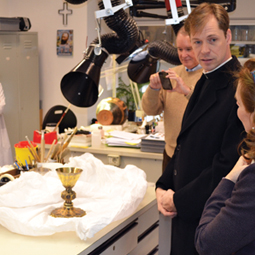Art for God’s Sake
Priest Discusses Vatican Masterpieces: One of the Vatican’s art insiders discusses the beauty and truth of sacred masterpieces and the book he wrote on the subject.

While he may not be an artist or have a degree in art history, Father Mark Haydu knows a thing or two about sacred art — specifically art from the Vatican. As the international director of the Patrons of the Arts for the Vatican Museums, he’s immersed in some of the world’s finest artwork day-in and "day-art."
The Legionary of Christ priest, ordained in 2007, has written his first book, Meditations on Vatican Art (Ligouri Publications, 2013). He recently spoke with the Register about the book and his passion for sacred art.
What inspired your book?
I serve as a spiritual director within the Legionaries of Christ, offering my expertise and background in the Spiritual Exercises of St. Ignatius of Loyola. My work with the young seminarians and my connection to the Vatican Museums represent two different yet convergent paths towards the mission of faith. Art is one of the most important tools we can use in theology and prayer, as well as outreach to the faithful.
Didacticism, teaching and showing through visual imagery is at the root of the Catholic Church’s patronage of artwork through the ages. My book was inspired by this tradition and is an opportunity to share the extraordinary beauty and messages of art masterpieces from the Vatican, which were created for prayer and meditation. I wanted to help people discover the beauty of hearing God’s voice, echoed in the artworks that are displayed in the museums, within a book that the world can access and enjoy.
What does your job entail?
My role here is to coordinate the international activities of an international group of benefactors, the patrons, who generously contribute to maintaining the collections of the Church here in the Vatican. Many of the important restorations and acquisitions of the Vatican Museums have been made possible by the Patrons of the Arts.
As a non-traditional art historian, you bring a unique perspective to the subject of art. Tell us about it.
Although I am not an artist, nor an art historian by academic training, my life is immersed in visual art every day. The subject of art is not just a passion of mine; through my work as an inside observer — whether in the galleries or restoration labs of the Vatican Museums — I have learned an enormous amount about art, artists, materials, processes of its restoration and preservation and about its link to the history of the Church. My daily experiences shape me as a non-traditional art historian; learning about art, for me, is an ongoing work in progress.
How vast is the Vatican art collection? In writing your book, what struck you personally?
There are hundreds of thousands of art pieces within the collections of the 12 museums that make up the Vatican Museums. I am constantly struck by the communicative power of the art here. Images that have really struck me are by artisans and craftsmen, which portray the suffering of colonized peoples and by inspiring underprivileged women on the Tiber Island of Rome, who learned embroidery (an initiative of Pope Pius IX in the 1860s) and enlarged their horizons in producing some of the most beautiful vestments of the popes, which are conserved today in the Vatican Museums.
Why is sacred art important?
There is much debate on the term "sacred art"; in a sense, all art is sacred, because it is the fruit of the artist’s God-given talent and an imitation of who God is at his essence — Creator. Sacred art is important as a universal language. There can be up to 2,000 people gathered inside the Sistine Chapel, from a myriad of different cultures and languages, and, yet, all are touched by the power of its imagery. Art speaks in different ways to different souls: One work of art can console one person, inspire another and challenge a third. It is a communicative tool that reflects the transcendence of the human spirit.
Today, so many images that vie for our attention are sensual, superficial and shallow — their only goal is to grab our attention for a moment. Yet we thirst for something more. Humanity is starving for the deep-rooted beauty and profound truths that emanate from sacred art. This hunger can be quenched by great art, music and architecture.
How do you respond to those who say that the Vatican has too much money in fine art? Why isn’t that money used to help the poor?
If the Catholic Church did nothing for the poor and had this amazing collection, then I would surely say that something was terribly wrong. Yet the Church does more for the poor around the world than any other institution, and the Church also reaches out to the cultured and the educated. It lifts people out of poverty and inspires them to appreciate and to strive after participating in humanity. Even more important is the work that the Church does to change hearts, motivate generosity and inspire lives that imitate that of Jesus Christ, who laid down his life for the poverty of his brothers.
The Church is the first to offer material help as well as spiritual and social support to millions of poor. Yet it is also the first to educate and honor the beauty that results from the highest aspirations and skills that humanity possesses.
A pilgrimage to the Vatican changes one’s life, and the art there makes an indirect contribution to this change, often resulting in untold generosity towards one’s neighbor.
Eddie O’Neill writes from
Rolla, Missouri.













